When success no longer feels satisfying, it may be time to pause, reflect, and redefine what “more” means for you. This post offers steps to help you reconnect with what brings energy and meaning—and reminds you that feeling stuck is often the start of something...
Read MoreBook List
Certified Performance Coach




